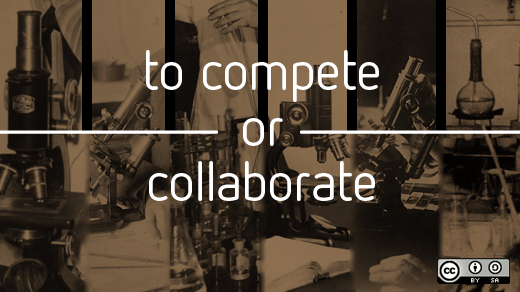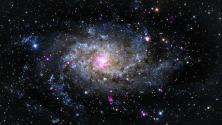Science can only advance when discoveries are shared, but scientists often have a disincentive to disclose their research. So says a group of researchers from Georgia Institute of Technology in their recent article on voxEU.org, Do academic scientists share information with their colleagues? Not necessarily. In fact, scientists often make complex, calculated decisions when asked to share data:
“Consider the behaviour of two scientists deciding whether to share materials (such as a cell line) or data with each other. If one scientist shares her materials, she increases the likelihood that the other scientist will solve the problem before she does. On the other hand, sharing has the potential benefit that the other scientist may share his materials in the future. This has clear elements of the well-known prisoners’ dilemma; both scientists would be better off if they shared, but neither does so unless the situation is expected to arise again and often. When the prospect of sharing occurs repeatedly, the scientists weigh the current gain from refusing to share against the expected loss from the lack of access to materials or data in the future.”
Nature magazine puts it more succinctly: “Sharing data is good. But sharing your own data? That can get complicated.”
Scooped
By far the biggest fear seems to be scooping: someone else beats you to the big discovery, using some of your shared information. In 1953, geneticist James Watson and biophysicist Francis Crick were racing against chemist Linus Pauling and X-ray crystallographers Rosalind Franklin and Maurice Wilkins to discover the structure of DNA. According to Nature's annotated version of the famous Watson and Crick paper, Linus Pauling was the first to discover the helical structure of some proteins, publishing his proposal of a triple helix model for DNA in early 1953. Though flawed, Watson and Crick found the necessary details in this model to beat Pauling to the solution:
“Pauling's proposed three-stranded helix had the bases facing out. While the model was wrong, Watson and Crick were sure Pauling would soon learn his error. They estimated that he was six weeks away from the right answer. Electrified by the urgency—and by the prospect of beating a science superstar—Watson and Crick spent four weeks obsessing about DNA in endless conversations and bouts of model-building to arrive at the correct structure.
In 1952, [the head of the King’s laboratory] denied Pauling's request to view their X-ray photos of DNA—crucial evidence that inspired Watson's vision of the double helix. Pauling had to settle for inferior older photographs.”
We've all heard of Watson and Crick, but who among us knows of Pauling's work? The fear of being scooped is no small paranoia, and a big barrier to information sharing. And for scientists in the business world, sharing with competitors can mean losing the advantage of being first-to-market with a new product.
Poached
Many scientists have experienced the misappropriation of their ideas, but it remains a stinging experience. So the idea of freely presenting to the scientific community the research they've spent hours preparing—perhaps even prior to publication—is daunting. Can a scientist trust his colleagues not to pocket those ideas and represent them in a self-serving manner?
Even Watson and Crick were guilty of as much. Nature details the slight to Rosalind Franklin:
“Here, Watson and Crick say that they "were not aware of the details" of the work of King’s College scientist Rosalind Franklin—a statement that marks what many consider an inexcusable failure to give Franklin proper credit.
According to Lynne Elkin, a science historian at California State University, Hayward, it’s true that Watson and Crick were not aware of all the details of Franklin’s work, but they were aware of enough of the details to discover the structure of DNA. Yet this paper does not ever formally acknowledge her, instead concealing her significant role by saying they "were not aware" of her work.”
Franklin had been working on the DNA model question using X-ray crystollography to determine the structure. Just a few months before Watson and Crick's landmark paper, Franklin came tantalizingly close to discovering the correct model, but she did not recognize it in the photographs she took. Frustrated with the attitude of her college toward women, Franklin was preparing to leave King's College when fellow scientist Maurice Wilkins, a close friend of Crick, showed Watson a critical photograph.
In his 1968 book, The Double Helix, Watson describes how he traveled to King's College to persuade Franklin and Wilkins to work with himself and Crick before Pauling discovered the error in his model. Franklin refused, but as Wilkins and Watson left, Wilkins decided to show Watson Franklin's photograph 51. “The instant I saw the picture,” Watson wrote, “My mouth fell open and my pulse began to race.” The photograph's cross-shaped pattern of spots clearly indicated a helical shape.
Meanwhile, Watson and Crick also obtained the bulk of Franklin's (unpublished) research, including precise DNA measurements, from a colleague who had copies of it. Franklin's work gave Crick the necessary information to determine that DNA has two chains running in opposite directions.
Despite these significant contributions, Franklin was merely listed in the acknowledgements section without any details about her work. (Check out the whole controversy, including links to more information, in the annotated Nature paper.)
So it's easy to see how someone's research can be “borrowed” without appropriate recognition. But if anything, the Franklin-Watson story illustrates how a culture that avoids systematic sharing of knowledge actually encourages this sort of poaching. When the whole world has access to your data and research, it's far more likely that an unscrupulous or careless researcher will be caught failing to acknowledge the significance of existing shared information to their own work. And having twice obtained Franklin's work through questionable means, Watson and Crick had difficulty giving her suitable credit.
Misused
Though not as professionally damaging as having your work poached or scooped, there is perhaps nothing more frustrating to a researcher than seeing it misused or misinterpreted. Whether the data is used wrongly to advance a political position or simply misinterpreted out of ignorance, the experience makes that researcher and others hesitant to share in the future.
Open science must be partnered with a strong accountability system, perhaps more formal than the “Internet-as-public-record” variety used to establish reputation in open source software development communities.
Extraordinary benefits
But if the risks to practicing open source science are great, the benefits surpass them. Harvard professor Karim R. Lakhani has said that innovation happens “at the intersection of disciplines,” and the solution to one scientific field's perplexing problem can often be found by a scientist with a different discipline's perspective.
To a great degree, we have seen this with InnoCentive challenges, where organizations broadcast their tough problems and reward the submitter of the best solution—rarely a scientist from the same discipline—with hefty amounts of prize money. But InnoCentive does not release the winning solution for input, which Lakhani believes necessarily reduces the quality of the final implementation.
In addition, the Georgia Tech researchers have found that competition, especially where the commercial and intellectual value of prizes is significant, actually stifles the practice of open science. So much the same for patents and consulting opportunities. But when increased government funding relaxes the competition in a field, scientists are far more willing to share their research with each other.
Certainly prodding from funding agencies, journals, and scientific societies would help, Nature author Bryn Nelson reports. Among the disciplines that do share large amount of data, like atmospheric science or genomics, significant ground work has been done by these organizations and scientists in the field. Beyond professional expectations for sharing, centralized data repositories must be created and maintained, then standards for entering data established, which is more difficult for some disciplines than others.
But then, no one said open science would be easy. (Ok, maybe someone did. But he probably wasn't a scientist.) I'd love to read about your experiences with data sharing in science. Log in and tell your story in the Comments section below.







9 Comments